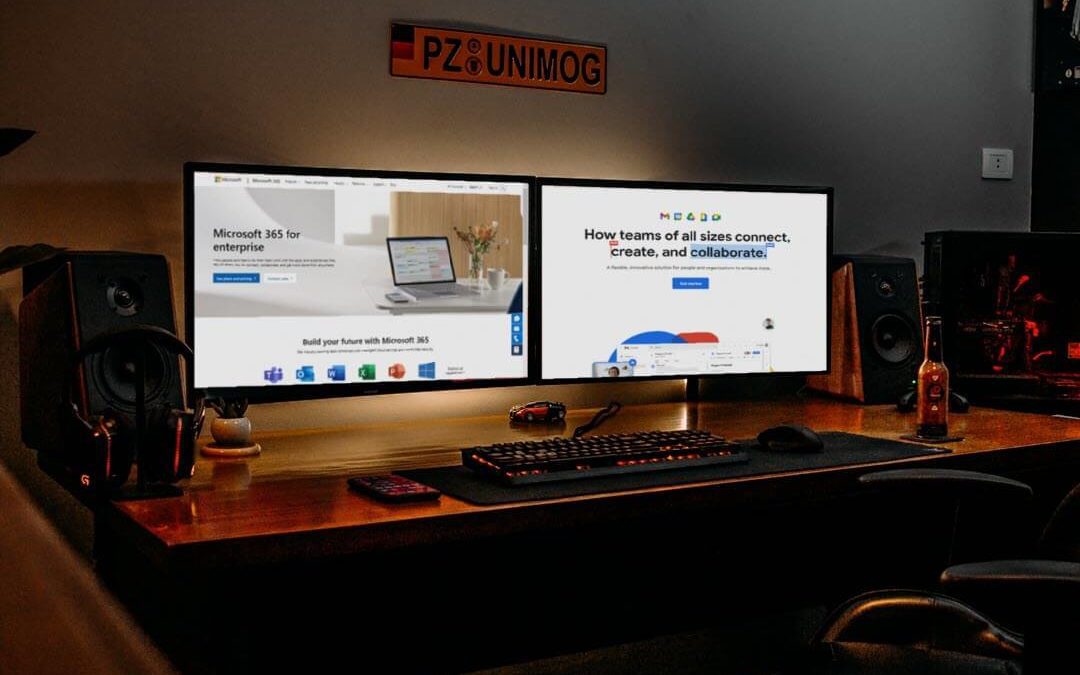Nearly all businesses are being run from home. Chances are, your team has only seen each other over video conferences in the past year.
To ease the stress of working from home, your office needs a virtual, user-friendly workplace setup. Two options are fighting to be the best option for your workplace: it’s Microsoft Office vs Google Drive.
So what option is best for your office? Read on to explore what both Google and Microsoft offer in their workplace platforms.
Pricing Breakdown
Both Microsoft 365 and Google Suite break down their prices by charging per user per month on a tier system.
Microsoft Office
Microsoft currently offers four different plans for businesses. Microsoft 365 Business Basic, the first and cheapest tier, costs $5 per user per month. This includes 1TB of cloud storage, Microsoft Teams, and web-browser versions of Office Applications.
The next tier, Microsoft 365 Business Standard, costs $12.50 per user per month. The plan includes everything from Business Basic, with the addition of desktop versions of Microsoft applications.
A step up from the Business Standard is the Microsoft 365 Business Premium plan. The plan costs $20 per user per month. Adding on to the previous plans, the Premium plan includes device management and cyber threat protection.
Aside from these three plans, Microsoft also offers a subscription plan to the Microsoft Apps for $8.25 per user per month. This plan only includes cloud storage and web, mobile, and desktop versions of the Office apps. It does not include business email and Microsoft Teams.
Google Drive – aka Suite or Workplace
Google offers three set payment plans and an enterprise option if your business needs more than these plans offer.
The first plan, “The Business Starter,” costs $6 per user per month. With this, users get a custom business email, 30GB of cloud storage, 100 person video meetings, and access to all of the Google web apps. Apps include Docs, Sheets, Slides, Calendar, Drive, which we will go into depth about later in this post.
The second and most popular plan is the “Business Standard.” It costs $12 per user per month. Along with access to the Google Suite of web apps and a secure business email, users can host 150 person video calls and take advantage of 2TB of cloud storage.
The final plan is the “Business Plus,” and costs $18 per user per month. This plan bumps up video calls to a 250 participant max and cloud storage up to 5TB per user. Unlike the other plans, Business Plus also includes eDiscovery, electronic discovery, and data retention.
Collaboration: Microsoft SharePoint vs. Google Sites
Microsoft Office and Google Workplace offer services to create sites for your team to share files. Google Sites allows anyone to create a website in just a few clicks to showcase projects or events.
Microsoft’s SharePoint is similar and allows users to create websites to store and share documents. To get the most out of SharePoint, consider reaching out for SharePoint consulting.
Word Processing: Microsoft Word vs. Google Docs
Both Google Docs and Microsoft Word have their own respective advantages. Microsoft Word is a great one-stop shop for any word processing you may need.
Word has templates for reports, resumes, brochures, you name it. Not to mention, Word has automatic spell check, word count, and you can find synonyms for words with a right-click.
With Google Docs, collaborating in real-time is a breeze. Just send the link to whomever you want to share with, and instantly you can be on the same doc instantly. There are features to add comments, edit the doc directly, and leave suggestions.
Data Processing: Microsoft Excel vs. Google Sheets
Both Microsoft Excel and Google Sheets are straightforward when it comes to creating spreadsheets.
Similar to Word, Excel has more features. This includes more templates and types of charts, including line, column, pie, etc.
Google Sheets, though, allows for simple collaboration and sharing. Another user can comment directly on cells and even add their data to tables if needed.
Presentations: Microsoft PowerPoint vs. Google Slides
The last of the main three creative platforms are the presentation applications: Microsoft PowerPoint and Google Slides.
Like the last two applications, Microsoft PowerPoint packs in more extensive features than Google Slides. Because of this, Google Slides is slightly easier to use simply because there are fewer options to choose from. On top of that, employees can easily work together in real-time on the same presentation.
Email: Microsoft Outlook vs. Gmail
Because of the popularity of Gmail, your employees might favor having Gmail out of familiarity. IT’s clean and simple to use. However, Microsoft’s Outlook might have more functional features for business.
With Outlook, users can create filters and groups for emails, making it easier to find clients’ emails.
Meetings: Microsoft Teams vs Google Meet
Many businesses need an easy, intuitive way to conduct meetings and chat with coworkers to accommodate remote work.
Microsoft Teams is Microsoft’s business messaging app. Within the application, users can direct message each other, send files, and attend video conferences. Teams is also highly integrated with the other Microsoft apps, making your workflow seamless.
For video conferencing, Google has Google Meet. Unlike Teams, it is not a desktop application, as it takes place in your internet browser. That said, the interface is very simplistic, making it easy to set up or join a meeting.
Desktop Applications
One big win for Microsoft Office is the ability to download the applications for desktop use. With Google, you can only access Docs, Slides, and Sheets through a web browser. While there is an offline mode, this can make it difficult for any unexpected internet outages.
Microsoft Power Apps
Does your business need to ability to easily create an app for desktop or mobile? This is another factor in deciding between Google and Microsoft.
Microsoft’s Power Apps allows you to create a professional-looking app, no coding experience is needed. But, if you do need PowerApps support, check out our Power Apps experts.
Google DOES NOT have an app maker anymore, so any apps would have to be built outside of the Google Workplace.
Microsoft Office vs. Google Drive: What’s Better for Your Workplace?
When it comes down to Microsoft Office vs. Google Drive, consider the following: Does your team value basic, live collaboration? Then Google Drive might be the answer. However, if your team wants more cloud storage, access to desktop apps, and more features within the apps, Microsoft Office might be the best option.
While both systems have their own support services, sometimes it is best to talk to a real person. For Microsoft Office support, contact one of our Office 365 consultants!
And if you want to learn more tips related to Microsoft and other business technology topics, check out our blog.



